During the year 1916 the Mediterranean Section of the University Museum acquired six vases of great importance. One of these, a red-figured pyxis, or toilet box, was described and illustrated in the last number of the JOURNAL. Another black-figured amphora is reserved for an article in a future number which will include a group of vases in the Museum which illustrate the exploits of Herakles.
A Diplyon Amphora
In the eighth century B.C. there was manufactured at Athens a style of pottery which is known among archæologists of the present day as Dipylon ware.. This name has been adopted because the potter’s quarter of that period appears to have been in the neighborhood of the Dipylon gate of Athens and because in the vicinity of that quarter quantities of this pottery have been found in the ancient tombs.
The Dipylon ware belongs in that class which is commonly called geometric, because it is covered with decorations, among which may be found straight lines, circles, squares, triangles, zigzags, and rectangular meanders, together with figures of men and animals drawn in a style peculiar to the period.
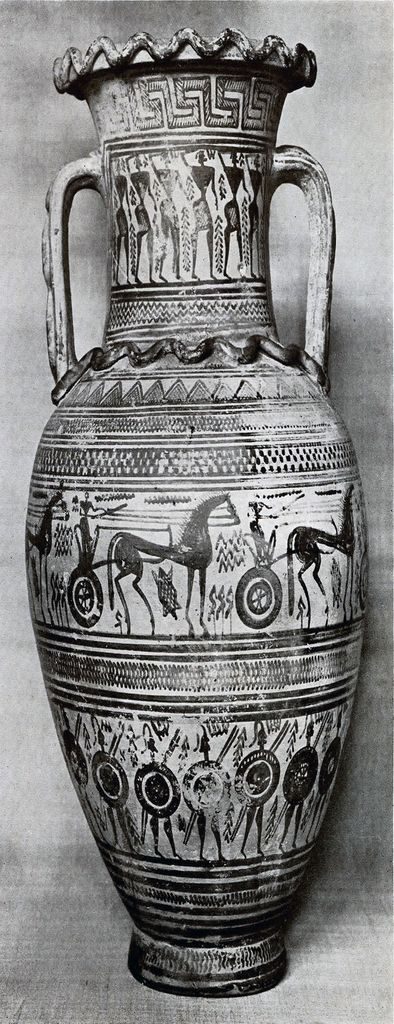
Museum Object Number: MS5464
Image Number: 3402
The collection of Greek vases in the University Museum has always been lacking in examples of Greek geometric ware generally and especially in examples of this Attic geometric or Dipylon ware. Dipylon vases are but rarely found and it is seldom that an American Museum has an opportunity of acquiring a specimen.
It is, therefore, a matter worthy of note that the University Museum has acquired a perfect example of the class. It is an amphora 43.5 centimeters in height, a fair size for vases of the class, although examples have been found of much greater height.
On the lip of this amphora runs a serpentine band of clay in high relief, painted red. This, combined with similar snake-like patterns on each handle and on the shoulder, may possibly point to the serpents sacred to Asklepios, the god of healing, and suggests that the contents of this amphora may have had medicinal properties.
This suggestion is not considered probable by the writer; but it is a possibility.
On the neck, from the lip to the junction of the handles, runs a heavy “maeander ” or “Wall of Troy” pattern. This is of the color of the clay, enclosed in black lines, which, as is true all over the vase, have turned red in places from over-firing. These outer lines are connected by cross-hatchings of black.
Below this is the principal representation of the neck: a group of men, each with his right arm raised, marching in procession. Notice the geometric drawing of these men and the lack of anatomical knowledge shown; for this drawing is characteristic of the “Dipylon” technique. In the field are ornaments supposed to represent foliage. This same conventionalized foliage is shown on the handles, and in all the bands of decoration where human figures occur. On the reverse women take the place of men in the neck decoration. Underneath these panels on the neck, which are enclosed on all sides by three heavy lines, a scale pattern appears which joins the neck to the shoulder.
As is usual in amphorae, the shoulder and body merge together. At the top, connecting the two handles, is found the serpentine motive, to which reference has already been made, underneath which is a design of triangles. This is separated from the neck by three lines; all of the bands of decoration are separated from each other by lines like these. Under these triangles comes a second set, then a lattice-work pattern, and finally a checker-board pattern. Then follows a typical band of painting, to be found in nearly every Dipylon vase that ever was painted. It is a band of chariots, in the characteristic manner of the period. Again, the geometric drawing both of men, chariots, and horses, should be noticed, especially the elongated bodies of the latter. Notice also the attempt to render both wheels by putting one inside the other. In the field we find more conventional foliage.
Between this band and the next are lines, on either side of a lattice-work pattern. Then comes a band of warriors. This, too, is a very common form of decoration, and almost universally found on vases of this class. These warriors carry the common round shield and spears. This is not always the case; for often on other vases of the same period warriors are shown carrying an enormous shield, in shape much like the body of a violin. This is called a Bœotian shield, from the place of its principal manufacture. Below this band of warriors, and on the foot, are horizontal lines, and a lattice-work pattern.
One point that will at once attract the notice of the observer is, that the chariots, while represented with a pole, seem to be drawn by one horse only. This is in reality not the case; the driver had at least two horses to his chariot, as the number of reins in his hand prove. The archaic vase-painters were not sufficiently versed in the art of perspective to render two horses.
A question arises: from what source does this geometric ware come? Archaeologists used to believe that the Dorians, when they invaded Greece, brought with them their own technique of pottery, and that it was this geometric style. This theory has been largely abandoned, and it is now believed that we must go to Crete and Mycenae for our sources. This belief has been turned almost to certainty by the excavations of Miss Edith H. Hall (now Mrs. Joseph M. Dohan), at Vrokastro, Crete, in 1912, conducted under the auspices of the University Museum. At that site early geometric and post-Mycenaean pottery were found together, showing that they were probably contemporaneous, although it is but just to say that Miss Hall reaches the conclusion that the presence of geometric ware on this site marks the Dorian invasion of Crete. To the writer, it seems more plausible to adopt the conclusion reached by Miss Richter of the Metropolitan Museum in New York, who declares in a recent article that “the post-Mycenaean geometric style is a continuation of the pre-Mycenaean geometric technique.”
In acquiring this vase, the University Museum has taken a great step in filling the gap in the continuous study of Greek vase-painting, which should be one of the ultimate goals sought by the Mediterranean Section. For this Attic geometric technique is perhaps as important as any of the later styles; and it is certain that no student can understand the later development of Greek vase-painting, until he can study the earlier specimens. We must constantly refer back to examples of this epoch in the history of Greek ceramics, in order fully to appreciate the excellence of the later periods.
Two Attic White Lekythoi
Another of these vases recently acquired also tends to fill a gap in the Museum’s collection of Greek pottery. This is an Attic white lekythos (Figs. 3 and 4) of the fifth century B.C. As is well known to the reader, these vases were not meant for household use; their purpose was strictly funereal, and they have invariably been found in tombs. Moreover, there is a possibility that in the late period of Attic vase painting, the makers and decorators of this class of pottery confined themselves to this branch of the ceramic art; for a passage in Aristophanes’ comedy of the “Ecclesiazusae” or “Women in Council” (lines 995, 996) refers to “the man who paints the lekythoi for the dead” (ὃς τοἳς νεκροἳσι ζωγραφεἳ τάς ληκύθους) as if it were all that he did. On the other hand, we have ample evidence that the leading artists of the early red-figured technique were also capable of work in the field of white ground vases. The example recently acquired is, as will be shown, early in style.
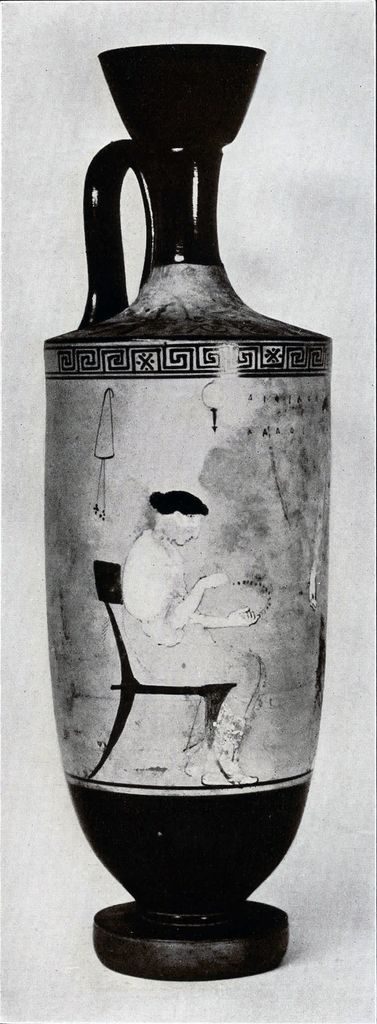
Museum Object Number: MS5463
Image Number: 3095
The subject of this recent acquisition is of great beauty, simplicity and restraint. At the left sits a woman (Fig. 3) with a circle of beads in her hands; she is evidently stringing them for use as a necklace. The chair in which she sits is of a graceful and beautiful design, and is drawn in a black wash on the cream-colored background. Her hair is rendered in the same manner. She is wearing two garments, a “chiton” and a “himation,” the “chiton” being the undergarment. This is rendered in a chalky white, much of which has flaked off, the idea being in this manner naturalistically to show the brilliant white of clean linen. The “himation,” being a shawl-like wrap of a heavier material, was rendered in the color of the background. Flesh parts are in this same chalky white, in a manner which, as will be shown, is peculiar to the maker of this vase. Above her, in the field, are hanging a mirror, and a long pouch, drawn together with strings, called by archæologists a “sakkos.”
In front of her stands another woman (Fig. 4), in a long, simple chiton, without sleeves. In her left hand she carries a large tray or basket, from which hang three fillets of white, and two longer ones of red, and which is filled with offerings of various sorts. Her right arm and hand hang at her side, and are most beautifully rendered. Above her in the field hangs an exquisite little pitcher. Between the two women is inscribed the dedicatory inscription, ΔΙΦΙΛΟΣ ΚΑΛΟΣ, “Diphilos is fair.”
Before coming to the Museum, this vase was at one time in the Borelli Bey collection, which was dispersed in Paris in 1913. In the sale catalogue, it is given the number 223, and is published on pl. XXIII. For purposes of convenience, and to avoid confusion fusion with the other white lekythos to be described, this vase will be called in the rest of this article the “Borelli lekythos.”
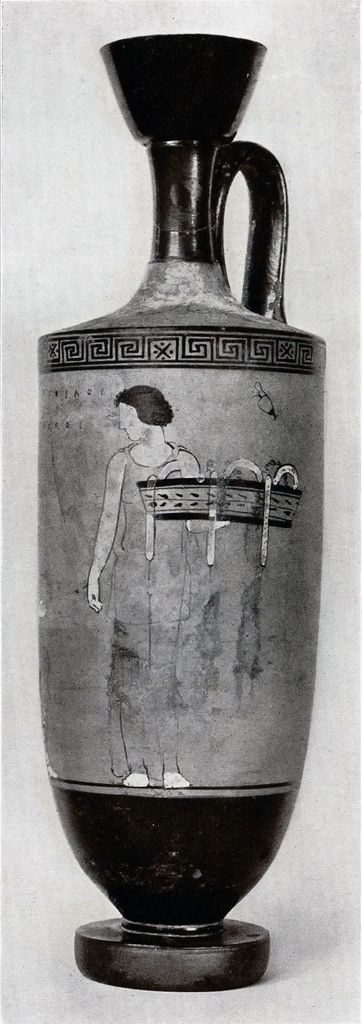
Museum Object Number: MS5463
Image Number: 3094
Many vases are known that bear the same dedicatory inscription to Diphilos, and nearly all are white lekythoi. Furthermore, it is possible surely to identify all these lekythoi as by the same hand. The artist uses other dedicatory names as well, of which Dromippos is the principal example; but Diphilos is the most common, and we know his father’s name, Melanopos, as some of these vases give it. The artist’s principal peculiarity is the use of chalky white for flesh parts, to which reference has already been made.
It is not necessary here to go into details, and show how we can date these “Diphilos” vases: it will be sufficient to point out that they have been proven by such scholars as Bosanquet, Fairbanks and Riezler, to be early in the history of Attic white lekythoi, and it is not without good reason that we can safely put this Borelli lekythos in the period of which the central date is 465 B.C. Nor will it be essential here, scientifically to put this vase into the class in the history of the white ground technique in which it belongs. Suffice it to say that it satisfies all the most rigid tests to which it could be subjected, and may safely be considered by the same hand that painted the fifteen or sixteen other white lekythoi with the same inscription, scattered through the museums of the world, and particularly, of course, in the National Museum in Athens.
Before turning to the second white lekythos, the writer wishes to bring out two points of comparison, on which he will lay much stress. First, we should notice the shape of the Borelli lekythos. Much of the dating of these funeral vases is based, not only on the technique of the drawing, and, in this case our knowledge of the identity of the person to whom the vase is inscribed (but such dedicatory inscriptions are very rare on white ground vases, which makes this vase all the more important), but on the shape of the vase. In this example, it is well nigh perfect, in the relation of the length of the neck to that of the body, in the beautiful bell-shaped mouth and gently sloping shoulder. It represents the very acme of the lekythos shape.
The other point is in the white ground and its composition. In this specimen, we find a hard, firm slip of cream color, perfect in preservation, unbroken and of extreme beauty. The early white lekythoi are all marked by this fine white ground.
The second vase has, as its design, two figures making offerings at a stele. Not meriting publication in itself, it nevertheless is important for purposes of comparison with the example just described. In the Borelli lekythos, we have the perfection of form of the early (and best) period; here, the neck is too long for the body, the body, in its turn, too short and attenuated for the neck, and the whole shape marked by carelessness of execution.
We notice, too, a great change in the texture of the white ground. In the Borelli vase, we commented on the firm, hard, and slightly lustrous slip of cream color. The vase painters of the period in which this specimen was made had either lost or discarded the art of creating such a white coat. Here we find the white to be extremely chalky and dead, easy to rub off, and, for that reason, hard to preserve. The design was originally very brilliant, as the vase was made at an epoch when polychromy had attained a great range; but owing to the poor quality of the slip, most of this has disappeared.
This comparison goes to show the great beauty and importance of the white lekythos recently acquired by the Museum.
Two Attic Red-Figured Amphoræ
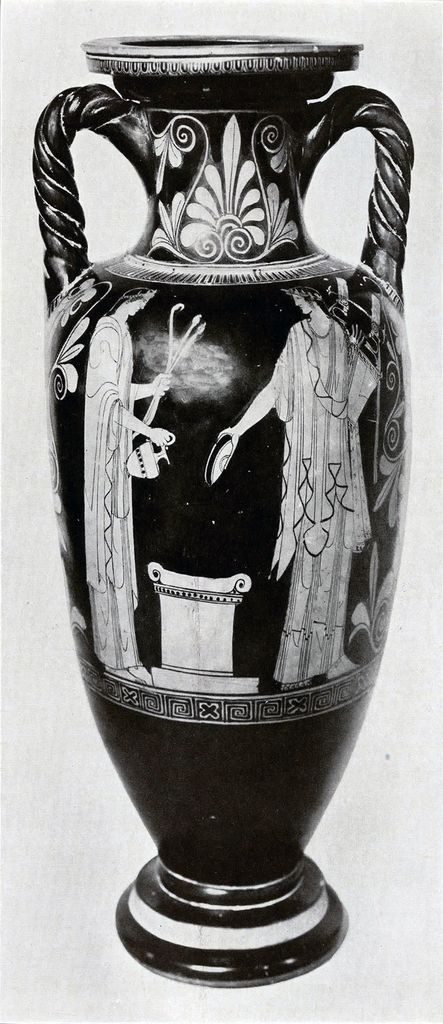
Museum Object Number: MS5466
Image Number: 2920
At the same time that the vases already described were obtained, the Museum also acquired two other amphoræ. These are of the Attic red-figured technique, and were made in the middle of the fifth century B.C.
One was found at Capua, which at the time this vase was made, was probably still under the Etruscans. It must have already begun to have the reputation for luxury which it certainly had two centuries later, and which became proverbial. Quantities of beautiful Attic red-figured vases have been found in tombs of this period at Capua, most of which are now in the Museo Nazionale at Naples. Capua was founded, according to tradition, by the Etruscans, about 600 B.C. Just after this vase was painted, or, in other words, in the last half of the fifth century B.C., the Etruscans lost the city to the Samnites, who soon became dependents of Rome. If our surmise is correct, this vase marks the last stage in the Etruscan domination, when commerce with Attica was still flourishing.
To return to the vase itself. Under the handles and on the neck are beautiful designs of palmettes. On the obverse (Fig. 5) we find two deities on either side of an altar. They are easily identified as Apollo, with his lyre, and his sister Artemis, with her bow and arrows. Apollo holds a phiale, or Patera, in his right hand; he is pouring a libation on the altar. Artemis does the same, from an œnochoe, or pitcher, in her right hand. Both wear beautiful and elaborate draperies, very carefully executed and falling in graceful folds. The drapery in each case consists of the “chiton” and the “himation,” which were explained in that portion of this article which dealt with the white lekythos. The himation of Apollo is especially elaborate and carefully rendered.
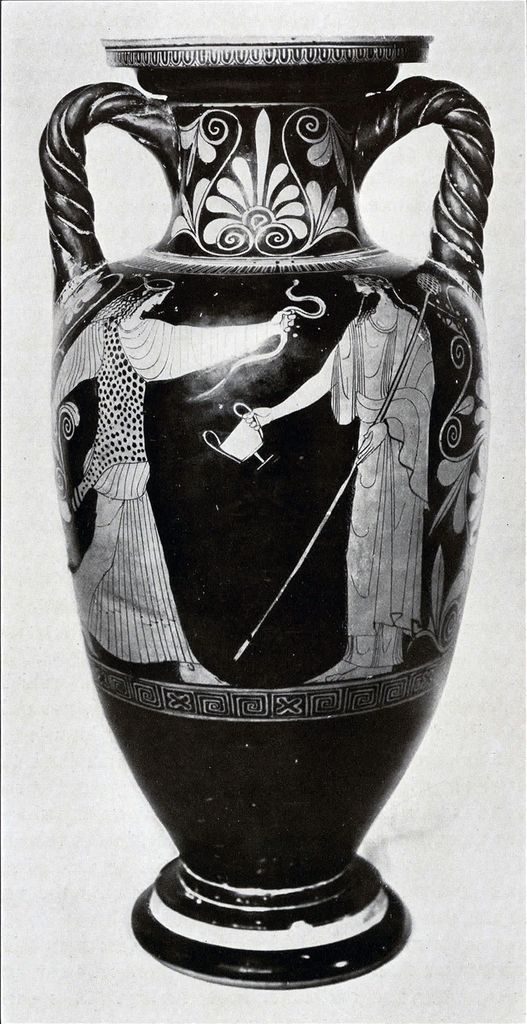
Museum Object Number: MS5466
Image Number: 2921
On the reverse (Fig. 6) is a different scene. At the right is Dionysos, the god of wine, bearded, and with a wreath of ivy on his head, draped in a chiton and a long himation. He stands in an attitude of calm, with his thyrsos in his left hand and wine-cup or kantharos in his right, in marked contrast to the “fine frenzy” of the Maenad, or Bacchante, who rushes towards him. She is clad in a long sleeved chiton, over which is the traditional panther skin. In one hand-she grasps a serpent, in the other (which does not appear in the photograph) she holds an œnochoe, or pitcher. Her hair, dressed in long ringlets, flies behind her.
The technique of this vase points to the first half of the fifth century B.C., the “strong style” of the Attic red-figured period. That this is true is proven by the drawing of the eye in the various figures. The artist does not know how to render accurately the eye in profile; but he knows too much to put it in full face, as do the earlier red-figured artists of the “severe” style. This would point to the end of the first half of the fifth century B.C., as a good date for this vase. Until this amphora was acquired, the Museum had no very good examples of this period, other than one or two kylikes, or drinking-cups; so that this vase, like the others described, is a most important accession.
The other red-figured amphora (Fig. 7) is of the shape called “Nolan,” from Nola in Campania, where the earliest examples of this shape were found, and which has continued to yield the greater number of specimens of this type. The provenance of this amphora is unknown, but it probably came from an Italian site. It is probably of later date than the vase from Capua, as is shown by the more correct drawing of the eye, and the fact that while great care is expended on one side, the other is carelessly drawn, showing that only one side was meant to be seen and examined closely.
The front picture is of Apollo. He stands before an altar, in a very erect position, with his lyre in his left hand, and a phiale, or patera, in his right. He wears a long chiton of fine linen, the quality of which is admirably indicated by the great number of lines which break up the light material into countless folds. Above that is a himation of heavy material, perhaps wool, fastened at the right shoulder by a brooch. The texture of the material, and the heavy folds into which it falls are admirably reproduced by a most judicious use of a relatively small number of lines. From the himation, on the right, falls a stole-like object, ending in a fringe. On his head is a wreath of laurel. On the reverse (not illustrated), is a woman with a pitcher, very carelessly drawn.
Until this vase was acquired, the Museum had no specimen of the “Nolan” amphora shape on exhibition, which gives the accession of this vase an additional interest.
S.B.L.
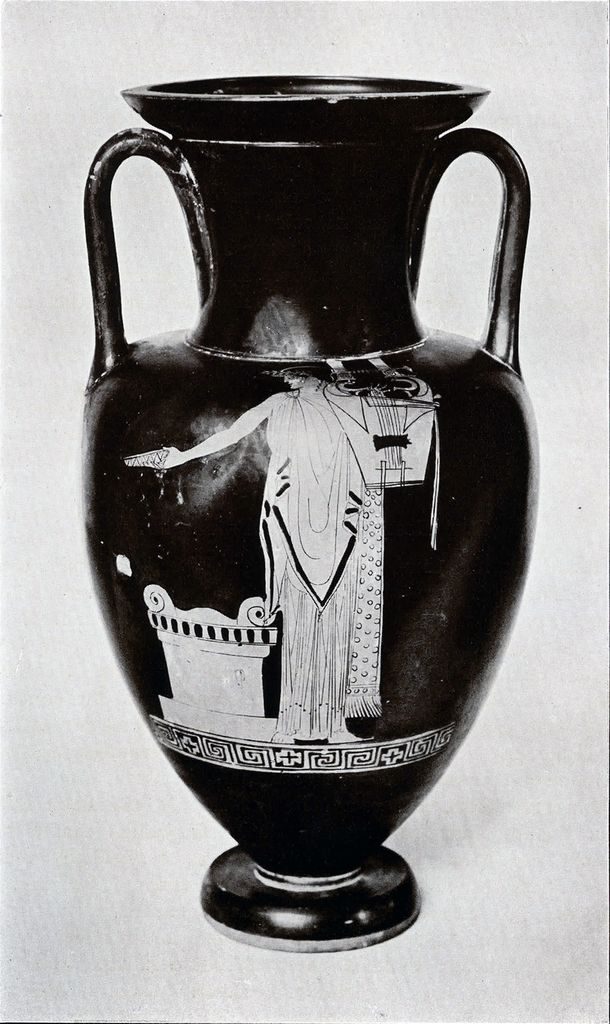
Museum Object Number: MS5465
Image Number: 120550

